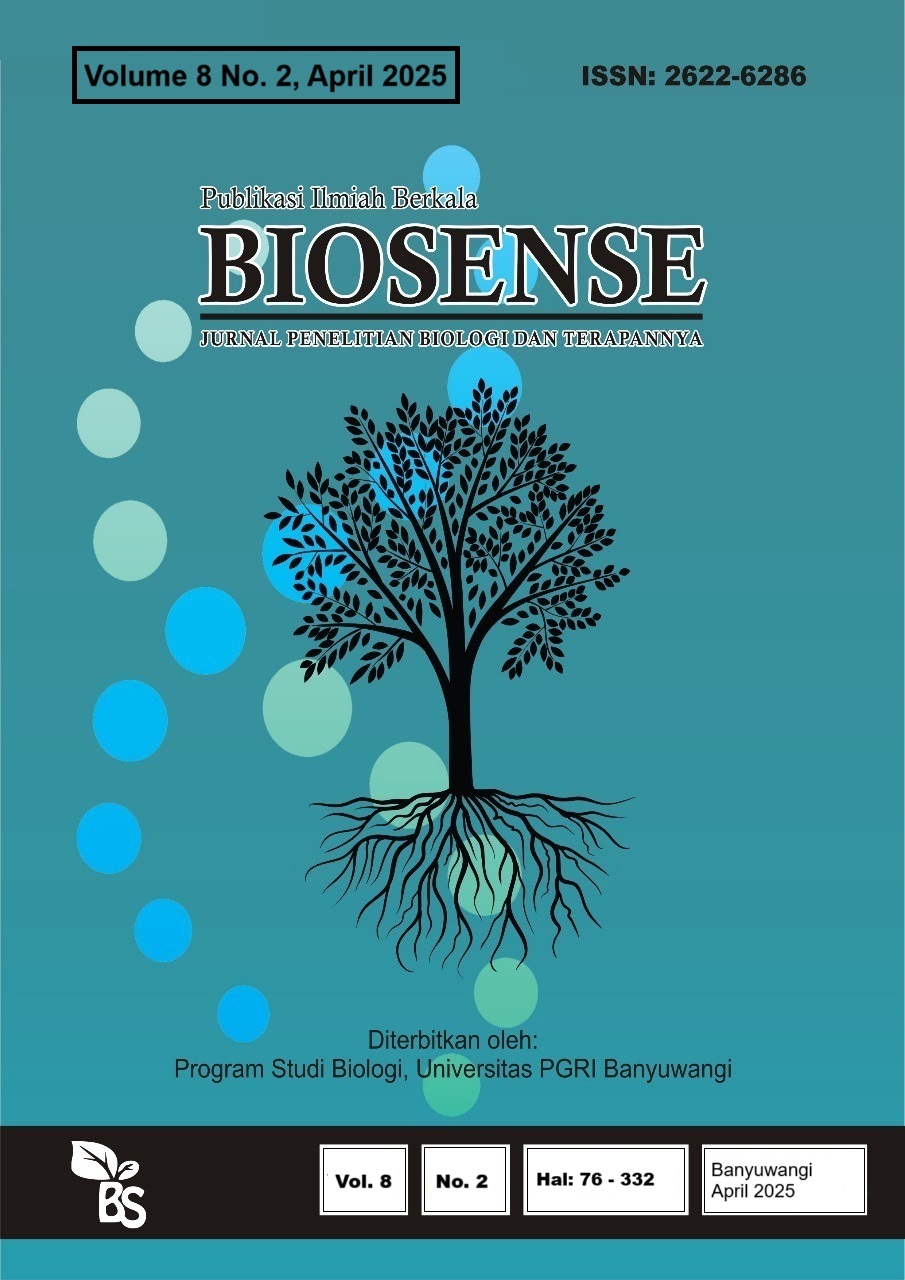Uji In Silico Peptida Bioaktif dari Protein Miosin Ikan Nila (Oreochromis niloticus) sebagai Antibiofilm Terhadap Staphylococcus aureus
DOI:
https://doi.org/10.36526/biosense.v8i2.5132Keywords:
peptida bioaktif, protein miosin, ikan nila, antibiofilm, Staphylococcus aureus, docking molekuler, PBP3Abstract
Salah satu produk turunan dari ikan nila yaitu peptida bioaktif dari protein miosin. Peptida bioaktif dapat berperan aktif di bidang kesehatan yaitu sebagai antibiofilm terhadap Staphylococcus aureus, bakteri penyebab infeksi pada manusia. Metode yang digunakan mencakup pemotongan protein menggunakan enzim pepsin dan tripsin, prediksi kelarutan, toksisitas, serta aktivitas antibiofilm menggunakan berbagai web server. Hasil penapisan menunjukkan 10 peptida yang memenuhi kriteria kelarutan yang baik dalam air, non-toksik, dan memiliki aktivitas antibiofilm. Analisis docking molekuler menggunakan AutoDock Vina menunjukkan bahwa 9 peptida memiliki nilai binding affinity (∆G) lebih negatif dibandingkan dengan cefotaxime sebagai ligan referensi, dengan nilai ∆G terendah mencapai -12,0 kcal/mol. Penelitian ini menunjukkan bahwa peptida bioaktif dari protein miosin ikan nila memiliki potensi sebagai antibiofilm terhadap S. aureus, yang dapat dikembangkan lebih lanjut dalam aplikasi teknologi hijau dan formulasi bio-sanitizing. Uji lanjutan secara in vitro perlu dilakukan untuk mengonfirmasi potensi antibiofilm dari peptida yang dihasilkan.
References
Alahyaribeik, S., & Nazarpour, M. (2024). Peptide recovery from chicken feather keratin and their anti-biofilm properties against methicillin-resistant Staphylococcus aureus (MRSA). World Journal of Microbiology & Biotechnology, 40(4), 123. https://doi.org/10.1007/s11274-024-03921-3
BIOVIA, D. S. (2024). BIOVIA Discovery Studio 2024 Client, 24.1.0. Dassault Systèmes.
Brosnan, J., & Brosnan, M. (2012). Glutamate: A truly functional amino acid. Amino Acids, 45. https://doi.org/10.1007/s00726-012-1280-4
Chen, L., Pan, Y., Cheng, J., Cheng, X. Z., Chu, W., Meng, Y. Y., Bin, S., & Zhang, J. (2023). Characterization of myosin heavy chain (MYH) genes and their differential expression in white and red muscles of Chinese perch, Siniperca chuatsi. International Journal of Biological Macromolecules, 250(125907).
Dallakyan, S., & Olson, A. J. (2015). Small-molecule library screening by docking with PyRx. Methods in Molecular Biology (Clifton, N.J.), 1263, 243–250. https://doi.org/10.1007/978-1-4939-2269-7_19
Forli, S., Huey, R., Pique, M. E., Sanner, M. F., Goodsell, D. S., & Olson, A. J. (2016). Computational protein-ligand docking and virtual drug screening with the AutoDock suite. Nature Protocols, 11(5), 905–919. https://doi.org/10.1038/nprot.2016.051
Hasan, R., Rony, M. N. H., & Ahmed, R. (2021). In silico characterization and structural modeling of bacterial metalloprotease of family M4. Journal of Genetic Engineering and Biotechnology, 19(1), 25. https://doi.org/https://doi.org/10.1186/s43141-020-00105-y
Innovagen. (2024). Innovagen. http://www.innovagen.com/
Jiang, Y., Sun, J., Chandrapala, J., Majzoobi, M., & ... (2024). Recent progress of food‐derived bioactive peptides: Extraction, purification, function, and encapsulation. Food …. https://doi.org/10.1002/fft2.383
Julia, G. I., & Komari, N. (2022). Virtual Screening Peptida Aktif Antikanker dari Myosin Ikan Gabus (Channa striata). Chemica Isola, 2(1), 84–93. https://ejournal.upi.edu/index.php/CI/index
Kaavin, K., Naresh, D., Yogeshkumar, M. R., Krishna Prakash, M., Janarthanan, S., Murali Krishnan, M., & Malathi, M. (2024). In-silico DFT studies and molecular docking evaluation of benzimidazo methoxy quinoline-2-one ligand and its Co, Ni, Cu and Zn complexes as potential inhibitors of Bcl-2, Caspase-3, EGFR, mTOR, and PI3K, cancer-causing proteins. Chemical Physics Impact, 8, 100418. https://doi.org/https://doi.org/10.1016/j.chphi.2023.100418
KKP RI, D. (2023). Profil Pasar Tilapia. https://kkp.go.id/storage/Materi/profil-pasar-tilapia667546f242cb9/materi-667546f2ca5fa.pdf
Koosehlar, E., Mohabatkar, H., & Behbahani, M. (2024). In Silico and In vitro Evaluations of the Antibacterial Activities of HIV-1 Nef Peptides against Pseudomonas aeruginosa. International Journal of Molecular and Cellular Medicine, 13(1), 46–63. https://doi.org/10.22088/IJMCM.BUMS.13.1.46
Le Gouic, A. V, Harnedy, P. A., & FitzGerald, R. J. (2018). Bioactive Peptides From Fish Protein By-Products BT - Bioactive Molecules in Food (J.-M. Mérillon & K. G. Ramawat (eds.); pp. 1–35). Springer International Publishing. https://doi.org/10.1007/978-3-319-54528-8_29-1
Li, Y., Li, S., Yang, K., Guo, R., Zhu, X., Shi, Y., & ... (2022). Antibiofilm mechanism of a novel milk‐derived antimicrobial peptide against Staphylococcus aureus by downregulating agr quorum sensing system. Journal of Applied …. https://academic.oup.com/jambio/article-abstract/133/4/2198/6989094
Lv, R., Dong, Y., Bao, Z., Zhang, S., Lin, S., & Sun, N. (2022). Advances in the activity evaluation and cellular regulation pathways of food-derived antioxidant peptides. Trends in Food Science & Technology, 122, 171–186. https://doi.org/https://doi.org/10.1016/j.tifs.2022.02.026
Meng, X.-Y., Zhang, H.-X., Mezei, M., & Cui, M. (2011). Molecular docking: a powerful approach for structure-based drug discovery. Current Computer-Aided Drug Design, 7(2), 146–157. https://doi.org/10.2174/157340911795677602
Mishra, R. A. K., & Muthukaliannan, G. K. (2024). In-silico and in-vitro study of novel antimicrobial peptide AM1 from Aegle marmelos against drug-resistant Staphylococcus aureus. Scientific Reports, 14(1), 25822. https://doi.org/10.1038/s41598-024-76553-0
Mora, L., M, G., & F, T. (2019). Degradation of myosin heavy chain and its potential as a source of natural bioactive peptides in dry-cured ham. Food Bioscience, 30, 100416. https://doi.org/https://doi.org/10.1016/j.fbio.2019.100416
Morozov, V., Rodrigues, C. H. M., & Ascher, D. B. (2023). CSM-Toxin: A Web-Server for Predicting Protein Toxicity. Pharmaceutics, 15(2). https://doi.org/10.3390/pharmaceutics15020431
Nurfaidah, Metusalach, Mahendradatta, M., & Sukarno. (2020). Analysis of molecular weight albumin concentrate on various types of freshwater fish using SDS-page electrophoresis method. IOP Conference Series: Earth and Environmental Science, 564(1). https://doi.org/10.1088/1755-1315/564/1/012057
Paggi, J. M., Pandit, A., & Dror, R. O. (2024). The Art and Science of Molecular Docking. Annual Review of Biochemistry, 93(1), 389–410. https://doi.org/10.1146/annurev-biochem-030222-120000
Pettersen, E. F., Goddard, T. D., Huang, C. C., Couch, G. S., Greenblatt, D. M., Meng, E. C., & Ferrin, T. E. (2004). UCSF Chimera--a visualization system for exploratory research and analysis. Journal of Computational Chemistry, 25(13), 1605–1612. https://doi.org/10.1002/jcc.20084
Prasetyo, A. (2024). In Silico Study of Bioactive Peptides from Nile Tilapia ( Oreochromis niloticus ) Keratin as Antibiofilm Against Staphylococcus aureus. The 2nd International Conference on Agricultural, Nutraceutical, and Food Science (ICANFS), 2, 10–18.
Puchakayala, H. C., Bhatnagar, P., Nambiar, P., & ... (2023). Design of a machine learning-aided screening framework for antibiofilm peptides. In Digital Chemical …. Elsevier. https://www.sciencedirect.com/science/article/pii/S277250812300025X
Shineh, G., Mobaraki, M., Bappy, M. J. P., & ... (2023). Biofilm formation, and related impacts on healthcare, food processing and packaging, industrial manufacturing, marine industries, and sanitation–a review. In Applied Microbiology. mdpi.com. https://www.mdpi.com/2673-8007/3/3/44
Terefe, E. M., & Ghosh, A. (2022). Molecular Docking, Validation, Dynamics Simulations, and Pharmacokinetic Prediction of Phytochemicals Isolated From Croton dichogamus Against the HIV-1 Reverse Transcriptase. Bioinformatics and Biology Insights, 16, 11779322221125604. https://doi.org/10.1177/11779322221125605
Toscano, M. D., Woycechowsky, K. J., & Hilvert, D. (2007). Minimalist active-site redesign: teaching old enzymes new tricks. Angewandte Chemie (International Ed. in English), 46(18), 3212–3236. https://doi.org/10.1002/anie.200604205
Tu, M., Cheng, S., Lu, W., & Du, M. (2018). Advancement and prospects of bioinformatics analysis for studying bioactive peptides from food-derived protein: Sequence, structure, and functions. TrAC Trends in Analytical Chemistry, 105, 7–17. https://doi.org/https://doi.org/10.1016/j.trac.2018.04.005
Vaidyanathan, R., Murugan Sreedevi, S., Ravichandran, K., Vinod, S. M., Hari Krishnan, Y., Babu, L. K., Parthiban, P. S., Basker, L., Perumal, T., Rajaraman, V., Arumugam, G., Rajendran, K., & Mahalingam, V. (2023). Molecular docking approach on the binding stability of derivatives of phenolic acids (DPAs) with Human Serum Albumin (HSA): Hydrogen-bonding versus hydrophobic interactions or combined influences? JCIS Open, 12(September). https://doi.org/10.1016/j.jciso.2023.100096
Varma, A. K., Patil, R., Das, S., Stanley, A., Yadav, L., & Sudhakar, A. (2010). Optimized hydrophobic interactions and hydrogen bonding at the target-ligand interface leads the pathways of Drug-Designing. PLoS ONE, 5(8). https://doi.org/10.1371/journal.pone.0012029
Wu, X., Wang, H., Xiong, J., Yang, G.-X., Hu, J.-F., Zhu, Q., & Chen, Z. (2024). Staphylococcus aureus biofilm: Formulation, regulatory, and emerging natural products-derived therapeutics. Biofilm, 7, 100175. https://doi.org/https://doi.org/10.1016/j.bioflm.2023.100175
Xu, Y., Lv, Y., Yin, Y., Zhao, H., Li, X., Yi, S., & Li, J. (2022). Improvement of the gel properties and flavor adsorption capacity of fish myosin upon yeast β-glucan incorporation. Food Chemistry, 397, 133766. https://doi.org/https://doi.org/10.1016/j.foodchem.2022.133766
Yu, Z., Wu, S., Zhao, W., Ding, L., Shiuan, D., Chen, F., Li, J., & Liu, J. (2018). Identification and the molecular mechanism of a novel myosin-derived ACE inhibitory peptide. Food & Function, 9(1), 364–370. https://doi.org/10.1039/C7FO01558E
Zhu, T., Yang, C., Bao, X., Chen, F., & Guo, X. (2022). Strategies for controlling biofilm formation in food industry. In Grain &Oil Science and …. Elsevier. https://www.sciencedirect.com/science/article/pii/S259025982200022X

















